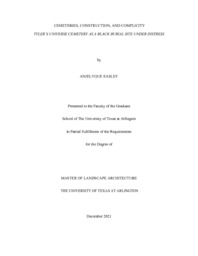| dc.description.abstract | Black culture has shaped the American landscape in unique but often unrecognized ways. Black burial sites and cemeteries honor ancestors and are a site of reverence (LaRoche & Blakey, 1997). However, they are routinely neglected, reflecting America’s history of segregation. Black burial grounds, places of connection to history and family, are often “repurposed” and forgotten as the changing of property ownership occurs. In many cases, through hostile zoning and real estate practices, Black burial grounds have been desecrated (Levinson, 2019). Urban infrastructures like major transitways have cut through Black cemeteries, effectively “burying” the existence of the Black landscape and those who rest there. These once treasured sites have become desolate patches of land because of ignorance, disrespect, and loss, with few policies and practices in place to allow their maintenance and preservation. Preservation Texas and the National Trust for Historic Preservation have identified historic cemeteries, particularly African American cemeteries, as some of our most endangered places (Way, 2019).
This thesis explores memory and cultural preservation as well as the long-term systemic threats to the survival of Black vernacular landscapes using the Universe Cemetery in Tyler, Texas, as a case study. Unfortunately, cemeteries often fall through the cracks of maintenance and caretaking across generations because of property ownership regulations. This is particularly true for Black cemeteries, including the Universe Cemetery, which does not benefit from perpetual care practices and lacks the protection of a legally recognized cemetery association (Way, 2019). The Universe Cemetery was established in 1870 and had a rich history that has been disturbed, forgotten, and recently rediscovered. A cemetery neglected and overgrown for decades is now nurtured by a small group of local historians and descendants who have begun small-scale efforts to document and clean up the site with the Smith County Historical Society (Lacy, 2020).
This thesis explores best practices in cultural landscape preservation and design by creating a maintenance plan for the cemetery that responds to the particular site conditions of the East Texas piney woods and honors descendants’ wishes. The methodological approach begins with a literature review assessing the history of segregation and its impact on Black cultural landscapes and gathers historical maps that allow an analysis of the cemetery’s relationship to the Universe community and the city of Tyler. Fieldwork on-site focuses on an inventory of extant grave markers and an assessment of their condition, as well as an analysis of site conditions. Oral history interviews with activists involved in preserving the site provide additional information about the cemetery’s importance to the Tyler community and descendants today. In the absence of an active cemetery association charged with maintaining the cemetery, these outcomes are shared with the Smith County Historical Society and the National African American Historical Society Museum in Tyler, Texas, to support record-keeping, accessibility, and connections with preservation programs for continued, organized maintenance support efforts. | |


